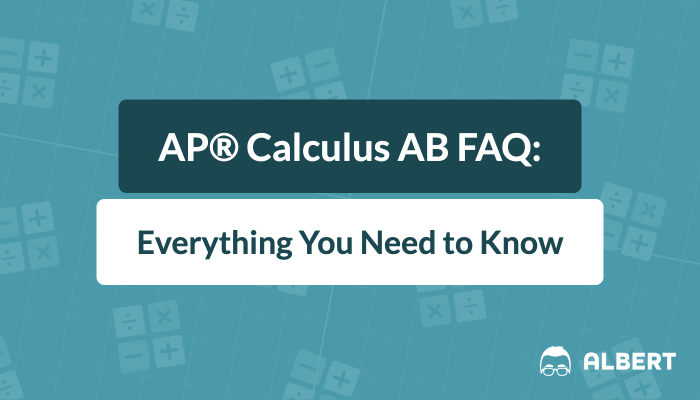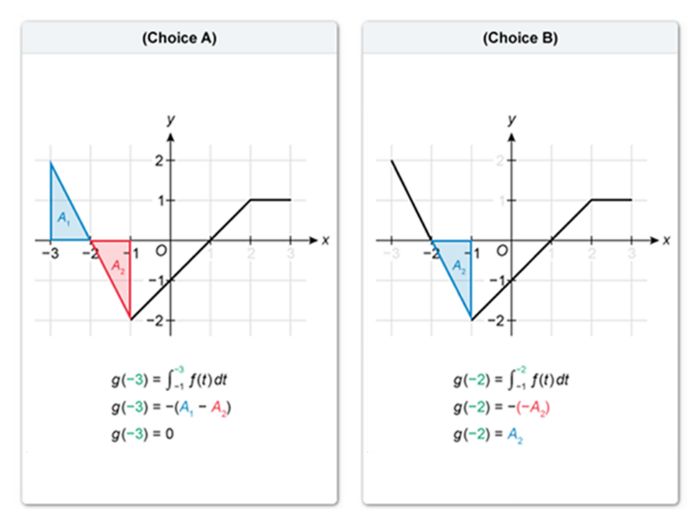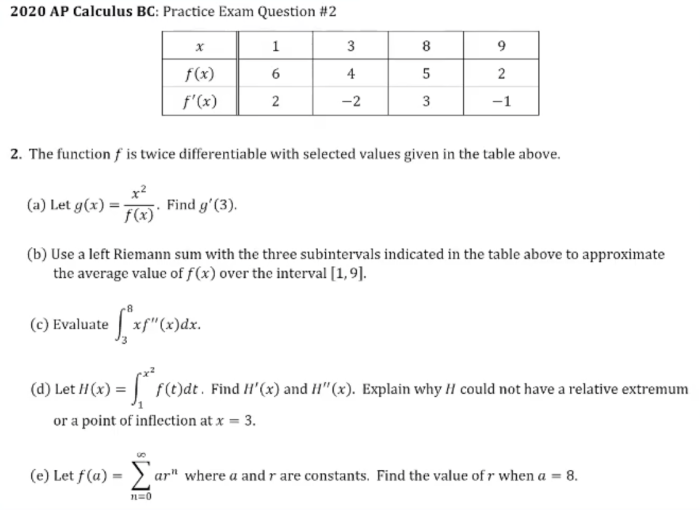Embark on a journey through AP Calculus AB Unit 1 FRQ, where the fundamentals of calculus unfold in an engaging and accessible manner. This comprehensive guide delves into the intricacies of limits, continuity, derivatives, and integrals, providing a solid foundation for your calculus studies.
As you delve deeper into this unit, you’ll discover the significance of limits in defining the behavior of functions, the power of derivatives in understanding rates of change, and the versatility of integrals in calculating areas and volumes. Prepare to unravel the mysteries of calculus and unlock a world of mathematical possibilities.
AP Calculus AB Unit 1 FRQ

AP Calculus AB Unit 1 FRQ is a crucial component of the AP Calculus AB exam, designed to assess students’ understanding of fundamental calculus concepts and their ability to apply them to real-world problems. The FRQ section tests students’ problem-solving skills, conceptual comprehension, and analytical thinking.
Key Concepts
Unit 1 FRQ covers several key concepts, including:
- Limits and Continuity
- Derivatives
- Applications of Derivatives
Structure and Format
The AP Calculus AB Unit 1 FRQ exam consists of three questions, each worth a total of 10 points. The questions are typically presented in order of increasing difficulty and require students to demonstrate their understanding of the concepts mentioned above.
Students are expected to provide complete and well-organized solutions to each question, demonstrating their ability to:
- Apply calculus concepts to solve problems
- Justify their reasoning and show their work
- Communicate their mathematical thinking clearly and concisely
Limits and Continuity

Limits play a pivotal role in calculus, providing the foundation for understanding the behavior of functions as their inputs approach specific values. They allow us to determine the value that a function “approaches” as its input gets closer and closer to a given point, even if the function is not defined at that point.Evaluating
limits involves various techniques, including algebraic methods like factoring, rationalizing, and applying L’Hopital’s rule. Graphical analysis, using graphs or tables, can also provide valuable insights into the behavior of functions near a given point.Continuity, closely related to limits, describes the smoothness of a function’s graph.
A function is continuous at a point if its limit at that point exists and equals the function’s value at that point. Continuity ensures that the graph of a function has no “jumps” or “breaks” at that point.
Algebraic Techniques for Evaluating Limits
Algebraic techniques involve manipulating the function algebraically to simplify it and make it easier to evaluate the limit. Common techniques include:
Factoring
Factoring out common factors from the numerator and denominator of a rational function.
Rationalizing
Removing radicals from the denominator of a fraction by multiplying both the numerator and denominator by an appropriate expression.
L’Hopital’s rule
The AP Calculus AB Unit 1 FRQ can be a daunting task, but with a little practice, you can master it. If you’re looking for some extra help, I recommend checking out this DMV CDL practice test for Connecticut . It’s a great way to get some extra practice in and build your confidence.
Once you’ve mastered the AP Calculus AB Unit 1 FRQ, you’ll be well on your way to success in the AP Calculus AB exam.
Used to evaluate limits of indeterminate forms (such as 0/0 or infinity/infinity) by taking the derivative of the numerator and denominator and evaluating the limit of the resulting expression.
Graphical Analysis for Evaluating Limits
Graphical analysis involves using a graph or table to visualize the behavior of a function near a given point. By examining the graph, we can often determine the limit of the function at that point.
Graph
Plotting the function and observing its behavior as the input approaches the given point.
Table
Creating a table of values for the function, with inputs getting closer and closer to the given point. The limit can be estimated by observing the values in the table as the input approaches the point.
Derivatives
Derivatives are a fundamental concept in calculus, providing a powerful tool for analyzing the behavior of functions. They represent the instantaneous rate of change of a function with respect to its input variable.
Geometrically, the derivative of a function at a point is the slope of the tangent line to the graph of the function at that point. This slope measures the steepness of the function’s curve and indicates the direction of its change.
Methods for Finding Derivatives
There are several methods for finding derivatives, each with its own advantages and applications:
- Power Rule:Used to differentiate functions raised to constant powers.
- Product Rule:Used to differentiate the product of two functions.
- Quotient Rule:Used to differentiate the quotient of two functions.
Applications of Derivatives
Derivatives have numerous applications in various fields, including:
- Critical Points:Identifying points where the derivative is zero or undefined.
- Extrema:Finding local and global maxima and minima of functions.
- Rates of Change:Measuring the rate at which a function changes with respect to its input variable.
Applications of Derivatives

Derivatives have extensive applications in various fields, enabling us to optimize functions, analyze graphs, and solve related rates problems.
Optimization of Functions
Derivatives are crucial in optimizing functions, which involves finding the maximum or minimum value of a function. By setting the derivative equal to zero and solving for the critical points, we can identify potential extrema. These points indicate where the function changes from increasing to decreasing or vice versa.
By evaluating the second derivative at these critical points, we can determine whether they represent a maximum or minimum.
Graphing and Analysis
Derivatives provide valuable information for graphing functions. The first derivative tells us the rate of change of the function, which helps determine intervals of increasing or decreasing. A positive derivative indicates an increasing function, while a negative derivative indicates a decreasing function.
The second derivative gives information about the concavity of the graph, indicating whether it is concave up or concave down.
Related Rates Problems, Ap calculus ab unit 1 frq
Derivatives are essential in solving related rates problems, which involve finding the rate of change of one quantity with respect to another. By relating the two quantities and differentiating the equation with respect to time, we can determine the rate of change of the desired quantity.
Related rates problems find applications in various fields, such as physics, engineering, and economics.
Integration

Integration is a fundamental concept in calculus that allows us to find the area under a curve and calculate the volume of solids.
Definition of the Integral
The integral of a function f(x)over an interval [ a, b] is defined as the limit of a sum of areas of rectangles as the number of rectangles approaches infinity. It is denoted as:
∫ba f(x)dx
Geometrically, the integral represents the area under the curve y= f(x)between x= aand x= b.
Methods of Integration
There are several methods for finding integrals, including:
- Power Rule:For integrals of the form ∫ ba xndx, where n≠ -1, the power rule states that ∫ ba xndx = [( xn+1 )/( n+1)] ba.
- Substitution Rule:The substitution rule allows us to change the variable of integration and simplify the integral. Let u= g(x)be a differentiable function. Then, ∫ ba f(g(x))g'(x) dx = ∫ g(b)g(a) f(u)du.
- Integration by Parts:Integration by parts is a technique used to integrate products of functions. It states that ∫ ba udv = uv– ∫ ba vdu, where uand vare differentiable functions and dv= v’dx.
Applications of Integration
Integration has numerous applications, including:
- Finding Areas:The integral of a function f(x)over an interval [ a, b] represents the area under the curve y= f(x)between x= aand x= b.
- Finding Volumes:Integration can be used to calculate the volume of solids. For example, the volume of a solid generated by rotating the region under the curve y= f(x)between x= aand x= babout the x-axis is given by ∫ baπ( f(x)) 2dx.
Applications of Integration: Ap Calculus Ab Unit 1 Frq
Integration is a powerful tool that has a wide range of applications in various fields of science, engineering, and mathematics. In this section, we will explore some of the key applications of integration, including finding volumes of solids of revolution, solving differential equations, and applications in probability and statistics.
Volumes of Solids of Revolution
One of the most common applications of integration is finding the volume of a solid of revolution. A solid of revolution is a three-dimensional object that is formed when a two-dimensional region is rotated around an axis.
To find the volume of a solid of revolution, we can use the following formula:
$$V = \pi \int_a^b [f(x)]^2 dx$$
where:
- $V$ is the volume of the solid of revolution
- $a$ and $b$ are the limits of integration
- $f(x)$ is the function that defines the radius of the solid of revolution
Differential Equations
Integration is also closely related to differential equations. A differential equation is an equation that involves derivatives of a function. Differential equations are used to model a wide range of physical phenomena, such as the motion of objects, the flow of fluids, and the growth of populations.
One of the most common types of differential equations is the first-order linear differential equation. A first-order linear differential equation has the following form:
$$y’ + p(x)y = q(x)$$
where:
- $y$ is the unknown function
- $p(x)$ and $q(x)$ are known functions
To solve a first-order linear differential equation, we can use the following formula:
$$y(x) = e^-\int p(x) dx \int e^\int p(x) dx q(x) dx + C$$
where $C$ is an arbitrary constant.
Probability and Statistics
Integration is also used in probability and statistics. In probability, integration is used to find the probability of an event. In statistics, integration is used to find the expected value and variance of a random variable.
For example, the probability of an event $A$ occurring is given by the following formula:
$$P(A) = \int_A f(x) dx$$
where $f(x)$ is the probability density function of the random variable $X$.
Popular Questions
What is the significance of AP Calculus AB Unit 1 FRQ?
AP Calculus AB Unit 1 FRQ introduces the fundamental concepts of calculus, providing a strong foundation for further studies in the subject.
What are the key concepts covered in AP Calculus AB Unit 1 FRQ?
Unit 1 FRQ covers limits, continuity, derivatives, and integrals, which are essential building blocks for understanding calculus.
How can I prepare for the AP Calculus AB Unit 1 FRQ exam?
Thoroughly study the concepts covered in Unit 1 FRQ, practice solving problems, and utilize resources such as textbooks, online materials, and practice exams.